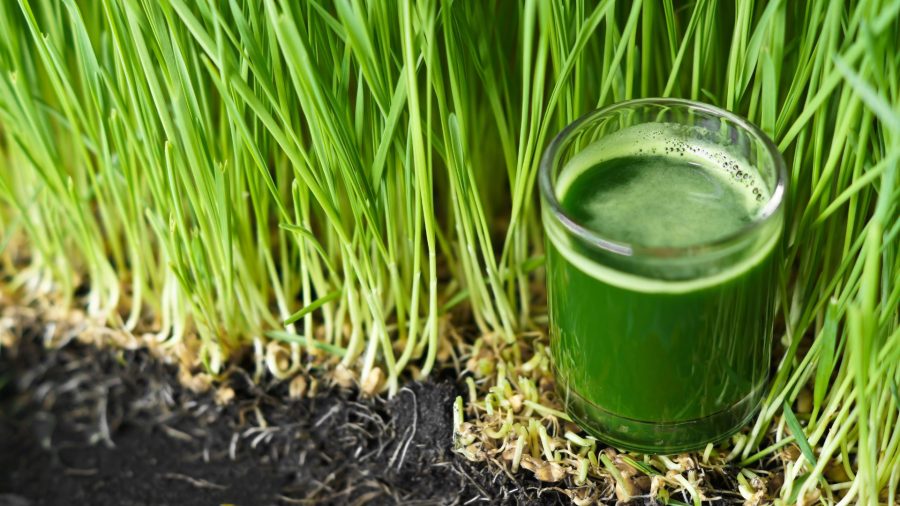Herbal, or alternative, medicine is gaining popularity worldwide. With growing awareness regarding personal health, consumers have become keener to read the ingredient list of food items.
Wheatgrass has become the latest health food item to gain popularity. It has health and fitness enthusiasts around the world intrigued by its nutritional profile. However, don’t be misled by its humble, lawn-like appearance, because this earthy grass is a rich source of chlorophyll and green food nutrition.
Wheatgrass refers to the young grass of the common wheat plant (Triticum Aestivum), which is freshly juiced or dried into powder for consumption. Chlorophyll present in wheatgrass acts as a natural detoxifier for the body.
It can either regenerate or act as a substitute of hemoglobin for people with hemoglobin deficiency. Considering this, wheatgrass consumption is often advised for people with clinical conditions such as thalassemia and hemolytic anemia, among others.
Green Blood Therapy (use of wheatgrass juice) is gaining popularity among people due to its blood purification, liver detoxification, and colon cleansing properties.
Wheatgrass contains almost all the nutrients our bodies require. Just two ounces of wheatgrass juice has the nutritional equivalence of five pounds of the best raw organic vegetables. It contains 98 of 102 earth elements found in soil, including calcium phosphorus, iron, magnesium, vitamins A, C, E & K, as well as essential enzymes and 17 amino acids.
Wheatgrass: the New On-the-Go Ingredient for Industries
Wheatgrass is consumed as juices, powders, and extracts. It improves immunity, helps in digestion, boosts metabolism, lowers cholesterol and blood pressure, enhances cognitive function, and eliminates toxins from the body. With its wide array of health benefits, wheatgrass is regarded as one of nature’s finest medicines.
Owing to its antioxidant and anti-inflammatory properties, wheatgrass has been found effective for the treatment of various diseases such as diabetes, obesity, blood disorders, gastrointestinal problems, oral cancer and inflammation. Increasing prevalence of these diseases bolsters the sales of wheatgrass products.
Pharmaceutical companies are adopting wheatgrass as an active ingredient in many of their formulations. Various wheatgrass syrups, capsules and sachets are being launched in the market. Many restaurants and hotels have added wheatgrass drinks to their menus.
Taking all that into consideration, FMI forecasts that wheatgrass product sales will rise at a 6.3% CAGR between 2021 and 2031.
Scientific Research Supports Wheatgrass Application
Uses of wheatgrass are no longer restricted to cosmetics or healthcare application. Experts predict impressive prospects ahead also as animal feed. Versatility of this ingredient has encouraged a slew of researches.
This has led to the development of hybrid wheatgrass species fit for human consumption. For instance, in 2020, the University of Minnesota released the first food-grade wheatgrass variety for public use. This eco-friendly and cost-effective crop can be commonly grown as human food. The new variety, called MN-Clearwater was produced by crossing seven wheatgrass parents with desired qualities.
According to a study published in the Journal of Clinical and Diagnostic Research (JCDR) in 2017, aqueous extract of wheatgrass has an inhibitory effect on oral cancer cell line proliferation. During the study it was found that increase in the concentration of aqueous extract of wheatgrass resulted in the decrease in oral squamous cell carcinoma (OSCC) cells proliferation.
Recent studies are encouraging diversity in wheatgrass application. From being used as a food product and in green blood therapy to a carcinogen-neutralizing agent, wheatgrass will remain highly sought-after as a natural herb.
COVID-19 Impact
COVID-19 resulted in higher demand for non-toxic and water soluble chlorophyll derivatives. Measurements suggested for building immunity against infections were abundant.
The biggest impact of COVID-19 on Ayurveda has been the change in mindset of consumers. Following the unprecedented outbreak, people have become more conscious about their health and wellness. A large number of organic medicines such as wheatgrass are being consumed by people to improve their immunity.
Thanks to the presence of omni-channel distribution, the sales of wheatgrass products remained positive even as pandemic caused supply chain disruptions.
The Way Forward
The scope of natural medicines, with their low cost and harmless nature, is quite broad. People in countries like India and China have been consuming herbal medicines for hundreds of years. This practice has started making deeper inroads worldwide.
Although wheat is grown on a large scale across these countries, people are not well-versed as to the various health benefits of wheatgrass. Growing awareness among people can play a crucial role in pushing wheatgrass sales globally.
Thanks to a slew of product launches, the availability of wheatgrass has considerably increased. Some of the leading food companies are looking at product launches to be a part of this bandwagon.
For instance, in December 2020, Fast&Up expanded its footprint in India’s plant-based nutrition with the launch of three new products under Terra Series- Joint care, Wheatgrass and Energy superfood.
Similarly, in 2020 Jivo Wellness, India’s largest seller of canola oil and wheatgrass products, launched a new range of products including basmati rice, muesli munch, choco flakes, wheatgrass summer drinks.
The Bottom Line
As veganism gains popularity, more consumers will show inclination for food items with ingredients derived from nature. Clean label and transparent ingredient lists are enjoying the spotlight as more consumers are buoyed by the life-altering claims of vegan components.
Consumers in general consider gluten-free products to be healthy alternatives to dairy or animal-based protein. This will continue supporting the adoption of wheatgrass, especially as a key ingredient in dietary supplements.
Wheatgrass, like other vegan ingredients, is a rich source of nutrition. It offers plenty of healthy benefits which will make it highly sought-after in the food industry. That said, some of the compounds found in wheatgrass also are present in spinach, kale, and other vegetables.
Nonetheless, experts believe an increasing number of consumers are expected to get lured by the curative and healing properties of wheatgrass. Coupled with this, the availability of powder wheatgrass should improve globally.
Download Free Sample: https://www.futuremarketinsights.com/reports/sample/rep-gb-1839
To contact Future Market Insights, email sales@futuremarketinsights.com.












